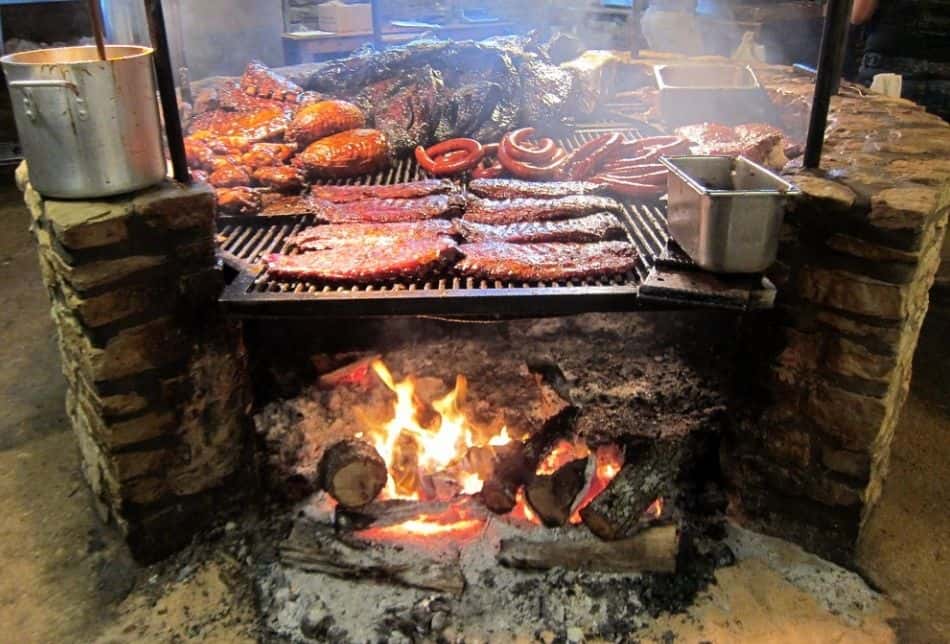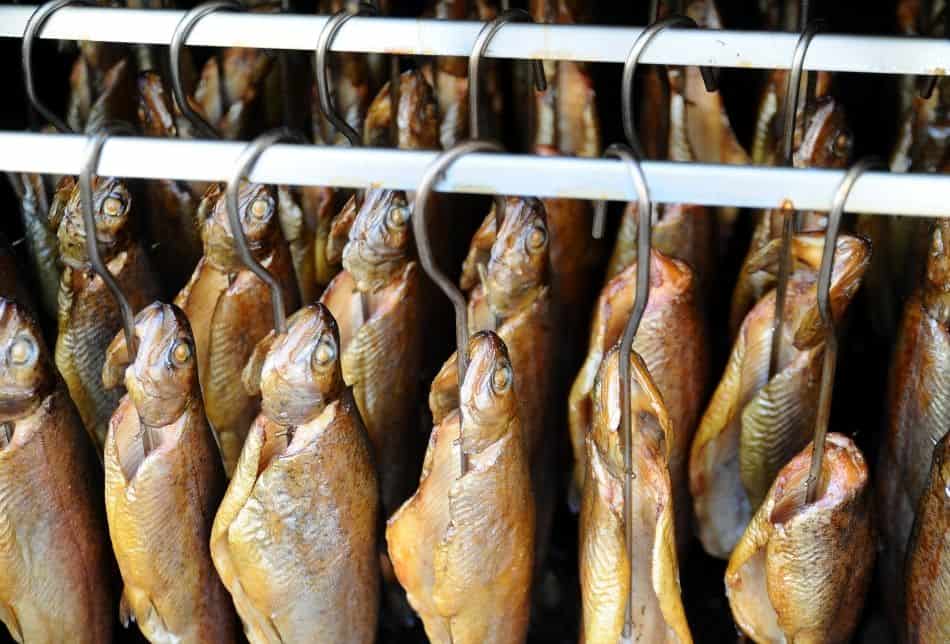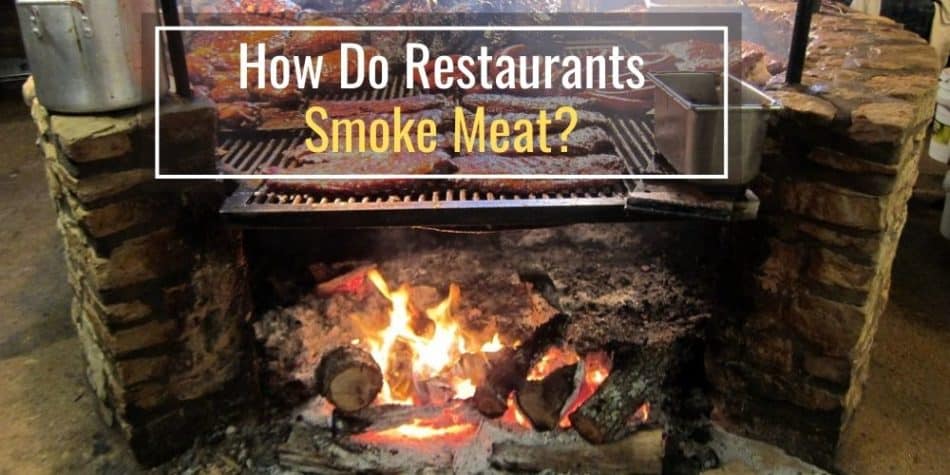Smoking meat started as a traditional method of food preservation. With the help of technological advances and culinary trials and errors, smoking has become a timeless art form.
Smoking food enhances the flavor, color, and texture.
However, it is essential to differentiate between smoke cooking (for preservation) and smoking for texture and flavor.
So how do restaurants smoke meat?
Restaurants commonly will use hot smoking in BBQ restaurants for meat. Cold smoking is commonly used for cheeses and fish. Some restaurants will use liquid smoking in order to create a smoky flavor without having to actually smoke the food.
So depending on what type of restaurant it is and the food being served, restaurants may use one of three common methods for smoking food.
Let’s dive into each type of smoking so we can see which method your restaurant uses.
Types of Smoking
There are 3 common ways of smoking food:
- Hot Smoking
- Cold Smoking
- Liquid Smoking
Let’s dive into each method with examples.
1. Hot Smoking
Hot smoking, also known as barbecuing, is where meat is exposed to both smoke and heat ranging from 180ºF to 300ºF to cook the meat.

Hot smoking adds flavor to the meat in three ways:
- Slowly cooking the meat making it tender
- Adding a smoky flavor
- Creating a crunchy exterior bark
Hot smoking is generally what folks think of when it comes to smoking since hot smoking can refer to:
- BBQ Pits (as seen in photo)
- Charcoal, Wood, and Propane Smokers
- Pellet Grills
Hot smoking is how most meats are smoked to create the fall-off-the-bone ribs or juicy brisket.
Generally, when people think of BBQ from a restaurant, they think of hot smoking.
2. Cold Smoking
Cold smoking is mainly used for preservation and adding flavor. The food is exposed to low-temperature smoke ranging from 60ºF to 120ºF with the heat being far away from the food.

Sinc Since cold smoking does not cook meat, the meat is cured before or throughout the cold smoking process.
Cold smoking is done over a long period (12 to 24 hours).
Therefore, the meat has to be cured, salted, or fermented to prevent microbial growth.
Cold smoking is also used for cheeses in order to create a smoky flavor on the cheese such as smoked gouda.
Once again the theme with cold smoking is using just the smoke to create flavor and not the heat to cook the food.
3. Liquid Smoking
Liquid smoke is a common smoking technique by lower-end restaurants because it adds a smoky flavor quickly.
Generally, liquid smoke is a flavor additive that comes in a bottle that can be added as the food cooks. Similar to adding BBQ sauce to ribs, liquid smoke can be added to meat before or while being cooked.
Although liquid smoke does create a smoky flavor, the smoke flavor can sometimes be described as artificial.
Not to mention liquid smoke does not create the distinct texture that can be created from slow-smoking meat.
Types of Smokers
After understanding the different types of smoking, you should learn about the most common types of smokers.
There are different types of smokers, and your choice can be determined by your budget, preference, and how you like your meat smoked.
1. Electric Smokers
These smokers are a combination of an oven that’s run primarily on electricity and a small compartment built inside the oven where wood chips are ignited.
The electricity heats up the heating element which causes the wood to produce smoke. The oven produces both heat and smoke which cooks the food.
Electric smokers are very easy to use because they have a temperature adjustment gauge. Generally, electric smokers create the least smoky flavor of all smokers.
2. Charcoal Smokers
Charcoal smokers are cheap, and barbecue masters prefer them because they imbue more flavor, unlike electric or propane smokers.
However, maintaining a charcoal fire to create the right amount of heat is both an art and a science.
Although charcoal smokers create the best tasting food given the charcoal flavor, they also take the most time and effort to use.
3. Wood Smokers
If you are looking for the purest flavor, restaurants with wood smokers are the best. However, wood smokers are not popular because keeping a constant temperature is challenging.
Not to mention, wood smokers need regular maintenance to clean and remove the soot.
That being said, wood smokers offer a wide variety of smoke flavors based on the wood being used.
4. Pellet Smokers
Pellet smokers use compressed wood pellets which make these smokers similar to wood smokers.
However, pellet smokers are one of the easiest ones to use since you just need to fill the smoker with wood pellets and let the machine do the rest.
Pellet smokers are electrical so the smoker will feed in pellets in order to maintain the fire and cooking temperature.
The drawback to pellet smokers is that the smoky flavor is not as intense as charcoal or wood smokers.
5. Propane Smokers
While they work similarly to electric smokers, propane smokers use a gas-fueled flame to make the wood pellets smolder.
In areas where electricity is expensive or scarce, most restaurants prefer propane smokers because they are affordable and easy to use.
Ideal Meats for Smoking
Whether you’re planning on smoking your own meat or purchasing some meat from a restaurant, it’s good to know which meats are the best for smoking.
Generally, smoking is a slow process ideal for tougher meat with lots of fats and collagen tissues. While the fat will keep the meat from drying out, the collagen tissues melt into tender gelatin.
The fats absorb smoke flavor and provide moisture during the long smoking process.
With that in mind, here are the best meats for smoking:
1. Brisket
Brisket is challenging to make with other cooking methods but ideal for smoking. Brisket is the most popular choice for smoking for a few reasons.
Brisket is a tough cut of meat that has a lot of fat which is perfect for smoking.
The meat will become more tender due to all the collagen tissues, not to mention all the fat will keep the brisket juicy and delicious.
A brisket that is allowed to smoke for 10 to 12 hours will transform from a tough hunk of meat to juicy goodness.
2. Pork Shoulder
Pork shoulder has numerous connective tissues and a lot of fat.
Similar to brisket, pork shoulder will take a long time to smoke in order to break down the connective tissue and render the fat.
After 10 to 14 hours and with a bit of spritzing with apple cider vinegar, the pork shoulder will turn into pulled pork.
Pork shoulder is common in most BBQ restaurants since pork is cheaper than beef and brisket.
3. Ribs
Ribs have the ideal ratio of meat, fat and connective tissues.
After a long smoking process, the meat around the bones softens up. However, ribs should be manned because they can be unforgiving and turn dry and tough if left unattended.
Woods for Smoking Meat
Wood is an integral part of the smoking process to add a smoky flavor to the meat.
However, the choice of wood can determine the type of flavor or how good the meat was smoked.
Here are the best woods used to smoke meat:
- Alder– has a naturally sweet flavor, making it an ideal wood choice if you are smoking white meat, poultry, and fish.
- Applewood – the fruity flavor pairs well with fish, poultry, and pork.
- Cherrywood – to smoke red meat and pork, cherrywood can come in handy. It can pair well with oak, hickory, and alder.
- Hickory – strong, distinct flavor makes the wood ideal for red meat, especially ribs.
- Oak – oak is the best to smoke big meat chunks that take longer to cook.
- Maple – used to smoke poultry and ham mainly, maple produces a sweet and delicate taste while darkening the meat you smoke.
- Mesquite – the wood has a strong, pungent flavor. Hence, if you do it wrong, it can overpower the meat. Avoid using mesquite with large meat cuts that require a longer time to cook.
Understanding the different methods of smoking meat, smoker options, and wood types will help you understand which meat you prefer.
At the end of the day, it all comes down to personal preference whether you prefer a smoked brisket or cold-smoked salmon.
That being said, this is how restaurants usually smoke meat:
Restaurants commonly will use hot smoking in BBQ restaurants for meat. Cold smoking is commonly used for cheeses and fish. Some restaurants will use liquid smoking in order to create a smoky flavor without having to actually smoke the food.
Be sure to check out our other articles if you’d like to learn how to smoke your own food at home.

